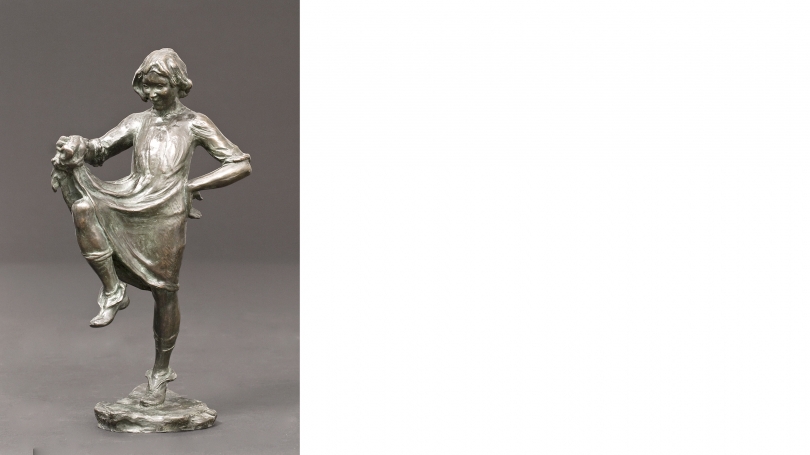Abastenia St. Leger Eberle (1878–1942) is best known for having created animated sculptures that reflect her interest in the everyday lives of immigrants in New York's Lower East Side. She was particularly drawn to female subjects, especially young girls at play. In Hurdy Gurdy, which she modeled around 1909, Eberle rejected the static forms and grand subjects she had been exposed to at New York's Art Students League, and created instead a lively, snapshot-like sculpture of an immigrant child dancing to a street musician. The girl may have been part of the performance or, more likely, a participant in an unscripted audience response, but her smile and exuberant skip make clear her pleasure. Both her clothing and comportment suggest her modest circumstances. She wears laceless, open shoes, oversized stockings that slip down her legs, and a simple dress, which, lacking petticoats, ties, or other adornments, enables her body to move freely.
As the work's title informs us, the girl dances to a hurdy gurdy, which is a partially mechanized stringed instrument with a long history in Europe. In the United States, however, the term more often referred to the crank-turned barrel organs played by organ grinders. These street musicians were ubiquitous on the streets of New York at the turn of the twentieth century, especially in working-class neighborhoods. In 1904, an observer of street life in the Lower East Side wrote: "The sound of the hurdy-gurdy on a warm spring evening is the signal for all the children in the neighborhood to assemble and to turn the sidewalk into an impromptu dance-hall. Children from eight to fourteen, with a natural feel for rhythm, keep perfect step to the changing time of the music, from polka to waltz or schottische, as the grinder goes through his repertoire."
For Eberle, her artistic practice and progressive social concerns were inseparable. Uncomfortable with her role as an occasional spectator in immigrant neighborhoods, she spent the summer of 1907 working in a settlement house on the Lower East Side so that she could, as she later described it, "get personally acquainted where I had so long been an onlooker." She later moved to the same neighborhood, where she dedicated a playroom for the local children, whom she frequently sketched. She later told a reporter that the artist "should be the 'socialist.' He [sic] has no right to work as an individualist without responsibility to others."
